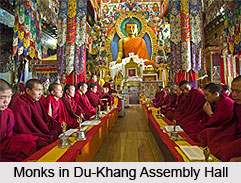 The Temple of the Enlightened Gods or gTsug Lha-khang, is also known as Assembly Hall or Du-Khang and forms the nucleus of the temple complex of Tabo-Chos-Khor, 46km east of Kaza in Spiti Valley, Himachal Pradesh. The temple possesses an antechamber, assembly hall and a sanctum. Vairocana is the focal figure, who, in Vajrayana Buddhism is regarded as one of the five spiritual sons of the Adibuddha, the primeval Buddha, who was self-created. He is presented as turning the wheel of law. The wall depicts 33 life-size images, commonly known as the `Vajradhatu Mandala`, along with other deities of the pantheon. These walls are further ornamented with paintings, which illustrates Buddha`s living.
The Temple of the Enlightened Gods or gTsug Lha-khang, is also known as Assembly Hall or Du-Khang and forms the nucleus of the temple complex of Tabo-Chos-Khor, 46km east of Kaza in Spiti Valley, Himachal Pradesh. The temple possesses an antechamber, assembly hall and a sanctum. Vairocana is the focal figure, who, in Vajrayana Buddhism is regarded as one of the five spiritual sons of the Adibuddha, the primeval Buddha, who was self-created. He is presented as turning the wheel of law. The wall depicts 33 life-size images, commonly known as the `Vajradhatu Mandala`, along with other deities of the pantheon. These walls are further ornamented with paintings, which illustrates Buddha`s living.
This article is a stub. You can enrich by adding more information to it. Send your Write Up to content@indianetzone.com





















